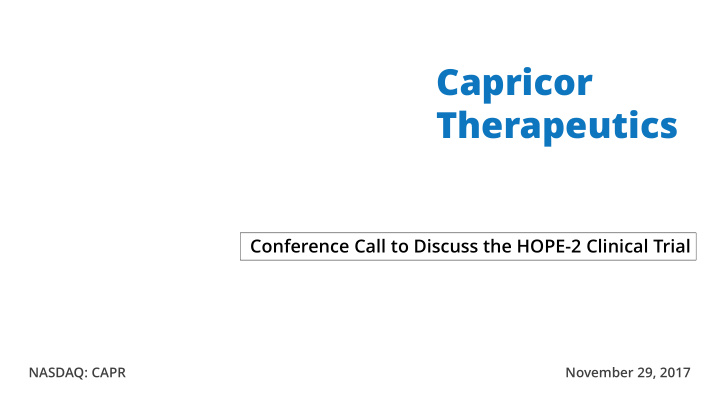



Capricor Therapeutics Conference Call to Discuss the HOPE-2 Clinical Trial NASDAQ: CAPR November 29, 2017
Forward-Looking Statements Statements in this presentation regarding the efficacy, safety, and intended utilization of Capricor's product candidates; the initiation, conduct, size, timing and results of discovery efforts and clinical trials; the pace of enrollment of clinical trials; plans regarding regulatory filings, future research and clinical trials; regulatory developments involving products, including the ability to obtain regulatory approvals or otherwise bring products to market; plans regarding current and future collaborative activities and the ownership of commercial rights; scope, duration, validity and enforceability of intellectual property rights; future royalty streams, expectations with respect to the expected use of proceeds from the recently completed offerings and the anticipated effects of the offerings, and any other statements about Capricor's management team's future expectations, beliefs, goals, plans or prospects constitute forward-looking statements within the meaning of the Private Securities Litigation Reform Act of 1995. Any statements that are not statements of historical fact (including statements containing the words "believes," "plans," "could," "anticipates," "expects," "estimates," "should," "target," "will," "would" and similar expressions) should also be considered to be forward-looking statements. There are a number of important factors that could cause actual results or events to differ materially from those indicated by such forward-looking statements. More information about these and other risks that may impact Capricor's business is set forth in Capricor's Annual Report on Form 10-K for the year ended December 31, 2016 as filed with the Securities and Exchange Commission on March 16, 2017, in its Registration Statement on Form S-3, as filed with the Securities and Exchange Commission on September 28, 2015, together with the prospectus included therein and prospectus supplements thereto, and in its Quarterly Report on Form 10-Q for the quarter ended September 30, 2017, as filed with the Securities and Exchange Commission on November 14, 2017. All forward-looking statements in this press release are based on information available to Capricor as of the date hereof, and Capricor assumes no obligation to update these forward-looking statements. CAP-1002 is an Investigational New Drug and is not approved for any indications. Capricor's exosomes technology, including CAP-2003, has not yet been approved for clinical investigation. Capricor 2
Capricor’s Product Pipeline Development Phase Candidate Indication Status Preclinical Clinical Market Improvement in skeletal and cardiac muscle function shown in randomized clinical trial in advanced DMD CAP-1002 Duchenne Muscular Dystrophy Orphan Drug and Rare Pediatric Disease (allogeneic CDCs) Designations; RMAT eligible Plan to initiate HOPE-2 clinical trial in 1Q18 Plan to submit IND in 2018 Hypoplastic Left Heart Syndrome Awarded NIH grant of up to $4.2 M CAP-2003 (CDC-exosomes) Inflammatory Exploring potential indications Disorders CDCs = cardiosphere-derived cells Capricor 3
CAP-1002 for Duchenne Muscular Dystrophy ‒ Uniquely positioned for DMD therapy Acts upon multiple pathways that are intrinsic to the DMD disease process Prospect of modifying the disease course in a clinically-meaningful way Potential to broadly serve boys and young men with DMD, irrespective of dystrophin mutation ‒ Clinical experience supports product development Clinical proof-of-concept established by HOPE trial Excellent safety record per cumulative clinical experience ‒ IND for HOPE-2 clinical trial cleared by FDA To initiate in 1Q 2018 Capricor 4
CAP-1002 – General Mechanism of Action ‒ CAP-1002 is a biologic product consisting of allogeneic cardiosphere-derived cells (CDCs) Manufactured from donated heart muscle Does not act by “stemness” – the cells do not engraft into host tissue Acts by releasing extracellular vesicles, or exosomes Contain non-coding RNAs and proteins Internalized by target cells Stimulate a diversity of lasting changes in cellular behavior Capricor 5
Studies in mdx Mouse Model of DMD – IV Delivery (n=6) (n=4) Exercise capacity of mdx mice given (n=4) CDCs by two IV administration routes. Exercise capacity of mdx mice (n=10) given escalating doses of CDCs. (n=4) (n=8) (n=4) Results presented at poster session at the Cell and Gene Meeting on the Mesa, October 6, 2017 Capricor 6
HOPE-2 Clinical Trial of CAP-1002 in DMD — To initiate in 1Q 2018 Randomized, double-blind, placebo-controlled Target enrollment of 84 patients with advanced disease Peripheral intravenous delivery – supported by preclinical studies Repeat-dose design – potential to achieve sustained benefit Primary efficacy endpoint = difference in change in mid-PUL scores at Month 12 Principal Investigator – Craig M. McDonald, M.D. — FDA willing to consider PUL as an efficacy endpoint for potential registration Type B meeting held in June, following six-month HOPE data — IND 30-day review period concluded on 24-Nov-17 with no clinical holds Capricor 7
HOPE-2 Trial Flow ‒ Expect to report top-line results in 2020 Capricor 8
Recommend
More recommend